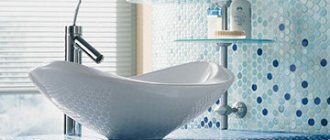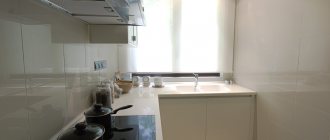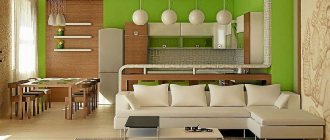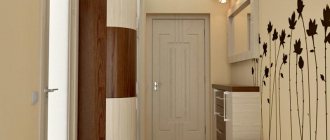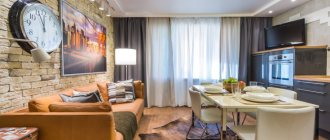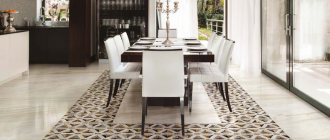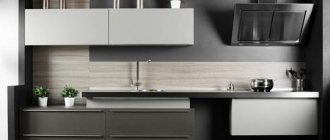The role of a kitchen apron is underestimated:
Due to the small area, it is possible to make an apron a cool accent without spending a lot of money on it.
The 2 most modern options for a backsplash are tiles and glass. But we will analyze the pros and cons of all materials.
I won’t remind you about this anymore, but take into account the size of the kitchen and the resulting density of objects. The smaller the area, the greater the concentration of kitchen utensils, and the fewer details there should be on the apron itself (i.e., without patterns, colors, etc.).
How to determine the size of an apron
This is the first place where the drafting begins. Most often, the height of the apron is 60 centimeters: this size is considered balanced and is perfect for people of short and medium height. But such people, especially among women, are the majority.
Designer tips
Irina
Irina Polyakova is the founder of an interior studio, architect and interior designer. The main area of work is kitchen design
I recommend to my clients to lower the apron a little (for example, 50-55 cm) if the upper cabinets on the door closers open upwards rather than to the side. This helps to avoid those awkward situations when not the tallest housewives have to call taller household members for help or stand on a stool to cover them
You should not carefully measure the indicated 0.6 meters down to the last millimeter: anyway, the edges of the material are hidden under the upper cabinets and countertops.
If you use a hood, then remember the “75-80 cm rule” - the optimal distance between it and the hob. The wall behind the hood can be decorated in the same manner as the apron. However, this is purely a matter of your taste.
If you decide to make the kitchen more spacious and abandon the top altogether, then it is best to extend the apron all the way to the ceiling. This design brings a nice Mediterranean or Scandinavian touch to the interior, where free space and ease of design are valued.
The voids can be filled with ordinary shelves. This is not only aesthetically pleasing, but also practical.
However, the option where the apron occupies about a third of the adjacent wall is also quite workable. The main thing is to competently play with the transition between materials.
The width of the apron depends on the type of kitchen unit and almost always corresponds to its length: if the layout is L-shaped, then we continue finishing around the corner - and so on around the entire perimeter.
Read more about corner kitchens here.
Designer tips
Irina
Irina Polyakova is the founder of an interior studio, architect and interior designer. The main area of work is kitchen design
Do you want to be original? Design a combined surface, where the sink and hob areas are decorated with one material, and everything else with another. This idea is often used in advanced interiors in terms of design ideas.
Combination of wood-effect tiles with natural wood
Wood-effect tiles in the worktop area go very well with the wooden flooring of the entire kitchen. The only problem with laying the floor this way is to choose or make the same thickness of tile and wood coverings.
What could the design and color be?
It is logical that the design of the apron directly depends on the design of the kitchen as a whole. A bright accent on this area with a neutral interior will look at least inappropriate. Therefore, when choosing:
- focus on the color of your facades, floors, curtains or countertops;
- avoid an overly grainy texture - it is extremely difficult to care for;
- Be careful with shades of black - water droplets and grease are especially noticeable on such a surface.
Our articles will help you decide on a color choice: 105 of the most stylish kitchen interiors in gray tones 143 fashionable beige kitchen interiors 120 photos of the most beautiful white kitchen interiors 109 fashionable kitchen interiors in blue tones
Very often, the apron is made in the same vein as the tabletop: the same material and texture, identical motifs. Differences may be in color intensity: a tone lighter or, conversely, darker. The white version, as in the photo below, is among the most common.
The opposite case is when a darker apron becomes a noticeable accent in a neutrally decorated room. Largely due to the integration of stone texture. Along with wood, it is appropriate for almost any kitchen.
Another way to beautifully highlight a backsplash is with an artistic panel. It is made from
- plastic;
- glass;
- ceramic tiles.
You have complete carte blanche to choose the type of image. True, appeals to kitchen themes (food, fruit, glasses, coffee, cups, plates) are among the most frequent.
For loft and high-tech it would be appropriate to preserve the “native” concrete texture. But you still have to prepare it: for example, varnish it, so that later you don’t have to spend hours (and unsuccessfully!) washing the walls from dirt and grease stains.
Owners of small kitchens can use a little trick and use an apron with horizontal lines. You will get an interesting optical effect of expanding space. Both striped plastic panels and popular ceramic subway tiles are suitable. It is also often called a “hog” due to Soviet custom.
You will find more options for designing a kitchen backsplash with boar tiles here.
Installation rules
Due to its high cost, porcelain stoneware aprons are most often used for heavy-duty coating. In order for the kitchen apron to hold firmly and serve for many years, it is necessary to follow all steps when laying the material.
Preparing the base
The main rule when preparing a wall is its smooth and clean surface. Here you must strictly follow a number of rules:
- Clean the walls from the plaster layer and peeling elements
- Fill all surface irregularities
- Corners should be straight if the material moves from corner to corner
- For better adhesion of the glue to the surface, it is worth making grooves on the wall
- Remove sockets and insulate wires
Laying porcelain stoneware slabs
Creating a porcelain stoneware backsplash consists of several steps:
Marking. To make an apron, you first need to calculate how many tiles you will need. To do this, you need to know the parameters of the floor cabinets and the height of the hanging cabinets.
Primer. You can create smooth walls on which the tiles will be laid using a deep penetration primer.
Guides. They are necessary to create an even tile layout. They serve as a support for the bottom row of tiles.
Angles. It is better to start laying tiles from the top corner. The adhesive solution must be applied to the wall and tiles. A short level can be used to check the evenness of the masonry. Then the whole process goes to the opposite corner. If the latter does not fit, then it can be adjusted to size using a grinder or tile cutter.
Applying glue. It is better to dilute the adhesive solution 2 hours before starting work, and the tile itself must be covered with the solution 15 minutes before adhesion. The product can be leveled within 10 minutes. The excess is removed using a notched spatula.
Holes. They are needed for sockets and switches. The mark is made in advance and drilled using a drill.
Seams. After finishing work, you should leave everything to dry for a day. After the required time has passed, rub the seams with a liquid of a plastic consistency. It must be prepared in advance. Using a rubber spatula, hammer the mixture into the seams and remove all excess. After half an hour, the surface can be washed to remove dirt.
Best materials
If there is a question that inevitably causes headaches when posed, it is this: what material is best to make an apron from? There are many of them - and each has its own obvious advantages and no less obvious disadvantages.
Tile
The first thing that comes to mind - and this is quite fair. Still, ceramic tiles are not afraid of water, fire, or alkali, are easy to clean and are almost eternal.
Probably, even in ten years, the boar tile will not lose its relevance. Available in sizes 10x30, 10x20, 8.5x10, etc. Such collections can be found in the catalog of any manufacturer. The differences are only in color variations.
When laying ceramics on a backsplash, seams inevitably remain. They should be rubbed down with a waterproof fugue: it retains the color better and does not fall out. When choosing a grout color, you have two options:
- make seams to match the tiles;
- follow the contrast method.
There are rectified tiles on sale - they are cut along the edge at an angle of 90 degrees and are joined with a minimum seam of 1 mm. This creates a cool solid surface effect.
Patchwork is another way to beautifully highlight this area, making it the main detail of the interior. The pattern on such a tile is not solid, but is a canvas woven from shreds with different patterns. Such elements are ideal for Mediterranean design, as well as for kitchens decorated in Provence or country style. You can choose collections where the tiles have a larger format: they are much easier to lay, and there will be fewer seams.
But for high-tech, embossed surfaces that are stingy with emotions are always relevant. However, when used correctly and with skillfully adjusted lighting, they demonstrate considerable decorative potential. But remember: with matte surfaces you will have to spend a little more time cleaning.
Designer tips
Irina
Irina Polyakova is the founder of an interior studio, architect and interior designer. The main area of work is kitchen design
The latest fashion is to lay ceramic floor tiles, stylized as wood, on the backsplash. There are pitfalls here: if the surface has an overly active topography, it will be very difficult to wash it off from dirt.
Expert opinion
Dmitriy
Sales consultant in a ceramic tile store
The problem of seams is easily solved by choosing large-format porcelain tiles with a polished or matte surface. We are talking about the size 60x120, which is literally created for modern aprons: minimal trimming, a beautiful and clear monolith, excellent compatibility with any type of tabletop. Such porcelain tiles are universal and are also used as flooring, but there are also exclusively facing collections with a thickness of 6-7 mm, where the weight of each tile does not exceed 5-6 kg.
Glass skins
Let’s clarify right away: high-strength tempered glass is used to decorate the apron. The technology is simple: a transparent screen is cut out based on the measurements taken and covers any initial wall finish. For example, photo wallpaper or vinyl stickers, as in the images below.
Such glass does not crumble into fragments, but into small and not at all sharp pieces, so the risk of injury is reduced to zero. Pros:
- durability;
- immunity to water and fire;
- easy care;
- solid decorative potential.
There are also options for skinning with photo printing. The higher its quality, the longer the design will retain its freshness and color. True, the price for such work is steep - and this is the main drawback of tempered glass as a material.
MDF panels and postforming
A great way to inexpensively and aesthetically decorate an apron. Especially suitable for those who are partial to the texture of wood - and want to fit it into the format of their kitchen. Fortunately, there are options on the market for a variety of breeds - you can satisfy any “wants”, and the convenient format fits well into the allotted height of 60 cm - there is less trimming and fuss with fitting.
Those who use a gas stove should look for other design methods: the material is afraid of high temperatures. Of course, you can always protect it with a tempered glass screen, but this is an additional expense - and it is not always possible to design the insert organically.
A good alternative is postforming , which is based on chipboard covered with laminated paper. Such an apron will definitely withstand any temperature influences, will not fade in the sun and will not lose its appearance. Since the strength is high, the material is also used as a tabletop. The result is an interesting monolith that brings orderliness and harmony to the interior.
Be careful: the cheaper the stoves, the more likely they are to contain resinous substances that are unacceptable in the area where food is prepared. Therefore, be sure to check the composition of the material with sellers: your health and safety come first.
Metal
If your kitchen is decorated in a strictly modern style, it makes sense to pay attention to stainless steel as a material for decorating the apron:
- reference wear resistance;
- does not scratch;
- is not afraid of fat, water, or fire;
- gives a beautiful mirror effect;
- goes well with the chrome inserts of the kitchen set.
It seems to have been created specifically for linear high-tech interiors, radiating cold calm and calm, restrained beauty. It is inexpensive and can be easily mounted on the wall, even by those who are only comfortable with a hammer and drill.
Metal does have one drawback - maintenance. Here housewives need to come to terms with the fact that traces of fat, fingers and other cooking artifacts will always be visible on the steel surface.
Mirror
On one side of the scale there is a magnificent reflection effect, due to which even the smallest kitchen is completely transformed and acquires a nice volume.
On the other hand, there are the difficulties of cleaning, because grease and water are clearly visible on the mirror surface. Are you ready for this?
This is how you can describe the advantages and disadvantages of a mirror apron.
Designer tips
Irina
Irina Polyakova is the founder of an interior studio, architect and interior designer. The main area of work is kitchen design
Of course, an infinitely nice option that makes a dark and uncomfortable room spacious and bright. It’s also cute because it easily fits into classic and modern. Just be careful with the shelves and kitchen utensils on it: such an apron reflects not only your beautiful face, but also numerous knives, forks, spatulas and other items from the housewife’s arsenal.
If you wish, you can choose a golden-colored mirror tile and play with the color of the fittings in your kitchen in this simple way.
Mosaic
One of the most impressive ways to decorate an apron. It looks bright, fresh, rich and stylish. May be:
- glass;
- ceramic;
- from natural stone;
- smalts.
Or from different components on one sheet, due to which it shimmers beautifully when illuminated and is equally successfully implemented into any design concept.
For example, a mosaic decorated in a metallic color fits perfectly into laconic and linear modern interiors. It is in them that it becomes the main accent, which attracts attention and makes the environment unique.
Individual pixels of a mosaic canvas can give an interesting mirror effect. In combination with beautiful lighting, it often looks simply stunning even in a relatively modest interior.
Smalt mosaic consists of a large number of glass cubes and plates connected to each other on a grid of any size. One sheet can have several shapes and a dozen colors at once, so such bright and rich elements will certainly appeal to fans of the colorful Mediterranean style.
By connecting sheets together on the apron space, you can achieve a smooth transition from one color to another. This gives rise to amazing harmony and charges the space with healthy energy.
Small pixel sheets contain countless numbers of equal sized cubes. Due to the mesh base, you can cut fragments to the desired height and length without any loss to the aesthetic concept. True, the boundaries between the pixels require methodical erasing: an epoxy fugue is suitable.
A reasonable question arises: if mosaic looks so amazing in the kitchen, why is it still not so often seen in modern interiors? The answer is simple: it is an expensive pleasure. In addition to the high price of the material itself, the costs will also need to include an increased fee for the installer for installation.
A large number of stitches makes care difficult and often even exhausting. However, there is always a way out.
Expert opinion
Dmitriy
Sales consultant at a ceramic tile showroom
If the mere thought of grouting mosaic joints makes you reach for the medicine cabinet for valerian, pay attention to ceramic granite imitation. Visually, it is still the same mosaic, but made using embossing technology. It is laid like a regular tile and grouted to match the color of the joints modeled on the surface. This is a good compromise for those who are delighted with mosaic compositions, but cannot afford such an expensive and capricious pleasure in everyday life.
Plastic panels
The cheapest and easiest way to solve the issue of an apron, which is suitable for those who live, for example, in a rented apartment. Or he simply does budget repairs.
PVC panels are attached to the wall using an aluminum profile and a small amount of glue. At the same time, it does not need to be prepared: it will be fixed even with visible defects and curvature. They are thin and light, so installation is simple and there is no need to call specialists for help.
One of the advantages of plastic for an apron, along with basic installation, is the wide selection of textures and colors. There really is EVERYTHING on sale - and sometimes it’s even difficult to determine that it’s PVC and not a more expensive and solid material.
Cons: plastic is not very durable, scratches easily, quickly fades in the sun. Usually its service life does not exceed 3-4 years. In addition, you cannot put it in the kitchen with a gas stove: it melts at high temperatures.
Artificial and natural stone
Man's desire for harmony with nature motivates him to surround himself with natural textures. Therefore, aprons made of artificial and natural stone are always relevant - and will remain so, even despite the huge amount of innovative materials generated by modern technologies.
The combination of an apron and a countertop made of the same stone is a completely logical design solution. At the same time, it is important not to overdo it with the amount of dark in the space: if you see that too much is brewing, restore the balance with light facades and friendly flooring.
Granite is always popular. Natural is quite expensive, but artificial - in the form of tiles 1.5-2 cm thick - will cost much less. Very dense and durable, not afraid of water, fire, or dirt. In general, a material that has practically no weak points.
Marble is more suitable for classic interiors that are meticulous to the smallest detail, where solidity, noble appearance and even some pomp are held in high esteem. Only in the good sense of the word.
Slate and brick also fit perfectly into any interior design, imbuing the space with natural textures. If we are talking about artificial stone, then you should choose concrete. Such boards are more durable than alternative, albeit cheaper, gypsum boards. And they can easily withstand any temperature changes, permanent exposure to water and soot.
Stone in any form is good as a facing material for an apron, but its popularity is limited by the rather high cost per square meter and complex installation. Therefore, many owners make do with its ceramic imitation: it is not so expensive, but still looks just as impressive. I mean, angrily.
Table of approximate cost of materials for decorating an apron
Nothing sobers us up from our crazy fantasies of modeling our dream interior like the prices of materials. Moreover, they are now changing at the same speed with which the leaves on the tear-off calendar disappear.
To make your search easier, we have compiled a small summary table that shows the minimum cost of an apron from each of the above groups of materials. The starting point was a standard area of 2.5 meters long and 60 centimeters high. Prices are current at the time of writing.
| Material | How much will an apron cost (RUB) |
| Ceramic tile | 1600 |
| Skinali (glass) | 3500 |
| MDF | 1400 |
| Postmorphing | 2600 |
| PVC panels | 1300 |
| Mirror tiles | 1900 |
| Glass mosaic | 7500 |
| A natural stone | 4500 |
| Artificial stone (concrete) | 2300 |
No. 3. Mosaic: room for imagination
Using mosaics, you can create the most incredible patterns and even entire paintings. A kitchen apron can become a real work of art, and the performance characteristics of the mosaic are very good. Among the main advantages it is worth noting:
- moisture resistance;
- heat resistance;
- easy to care for and hygienic;
- strength;
- wear resistance and durability;
- unique appearance.
These are all the general characteristics of mosaics, because they can be of different types and made from different materials:
- ceramic mosaic repeats all the characteristics of ceramic tiles, only you can lay out any patterns from tiles measuring 2*2 cm;
- glass mosaic performs well in operation, as it is completely inert to moisture and fire. In addition, this material can change color slightly depending on lighting conditions, which makes it even more unique;
- stone mosaic is quite rare due to its high price, and caring for it is difficult;
- metal mosaic is quite durable and practical, but you can’t rely on a variety of shades and colors.
The disadvantages of mosaics include the complexity of the installation process and, in some cases, the cost. A perfectly flat surface is needed, and grouting should be done extremely carefully so that dirt does not accumulate in them. Otherwise, this is an excellent material for finishing an apron in the kitchen.
Materials for an apron for a kitchen with a gas stove
If you have a gas stove in your kitchen, the space of options for covering the apron directly behind it is seriously narrowed. And it’s clear why: not every material is heat-resistant and can withstand moisture. To ensure that the apron does not deteriorate, you need to choose a covering that:
- calmly tolerates constant temperature changes;
- hygienically safe and does not emit harmful substances when heated;
- It is easy to clean and does not obediently absorb grease and soot.
Of course, stainless steel ideally meets all the points listed above.
You can safely add stone . All natural, this is an almost eternal covering that will withstand the culinary exercises of even the most active housewives. Artificial - only on a concrete base. And it is advisable to immediately coat it with varnish to make cleaning much easier.
The same goes for brick . Classic and fireclay, Turin, Sumerian - there are many variations. And the performance characteristics are always at the level.
Beyond competition - ceramic tiles . Both ordinary, with classic white, pink or any other color hog, and porcelain stoneware - with powerful slabs imitating concrete and stone. As a rule, they are large in size and immediately cover the entire apron space.
Tips for choosing a kitchen apron made of large-format porcelain stoneware
An apron made of such durable material has no equal. It can withstand aggressive cleaning, is not afraid of external threats and is not that expensive. If there is still a question about purchasing porcelain stoneware, then it is better to take into account several criteria when choosing.
This will help you choose the best tiles for your splashback from a huge variety of formats and designs.
- Degree of moisture absorption. Markings A and AA indicate that the tile will withstand any water attack and will not let liquid through.
- Matte finish. For those who cook often, it is better to look for a product with a matte or semi-matte finish for the apron. Unlike glossy, it is not at all afraid of scratches or impacts.
- Accounting for stock by 10-15%. In order not to worry about whether there will be enough tiles or not, it is better to take a reserve in case of a defect or a fight. Plus, you need to know all the necessary measurements in order to know how much product you will need for the apron. The main thing is not to forget that the tiles should extend 2-3 cm under the upper and lower cabinets. But don’t rush, it’s better to go to the store and write down all the options you like, indicating the article numbers, name, production and sizes. At home, work through all possible styling options or contact a store designer.
- Color of tiles and grout. White tiles and seams have to be grouted much more often. To avoid such hassle, it is better to make the seams dark or light gray. On black material, especially glossy material, fingerprints, grease, splashes and dust are highly visible. The grout mixture for kitchen backsplash tiles must be waterproof, dirt-repellent and anti-fungal.
- Party code. Not only the batch number, but also a numerical or letter code will help you successfully purchase tiles of the same shade. It must also match the style of the room. For example, for a rustic-style kitchen, a product in the form of stone or with colorful patterns covered with glaze is suitable. The color is not important when choosing, it is enough that it matches some interior elements.
- Universal tile. This category includes a product called “hog”. It fits into any type of interior and is convenient because the tiles can be laid in a herringbone pattern, in a staggered pattern, or seam-to-seam.
- Search for material. When it is difficult to find the desired porcelain stoneware, you can look for it among the floor tiles. Since it is resistant to abrasion and can withstand heavy loads, unlike wall-mounted ones.
Common mistakes
Everyone makes mistakes. But it’s better to learn from the mistakes of others - and to warn your own in time. We talk about some of the pitfalls that accompany the design of the apron area.
Dark tones combined with grainy texture
It looks incredibly impressive, bold and always relevant. But here’s the problem: any stains are clearly visible on such a surface, and grease and soot literally eat into the top layer of the tile. Get ready to scrub them endlessly - or immediately look towards other shades.
Snow-white seams
Many owners, when laying ceramic tiles on a backsplash, want to highlight the contrast and purchase an ultra-white fugue for grouting. Of course, it immediately makes a pleasant impression and favorably emphasizes all the advantages of the chosen tile. However, over time, even waterproof grout loses its color and the seams acquire an unattractive gray tint. Therefore, it is optimal to immediately make a choice in favor of options that are not clearly contrasting.
Poor quality installation of the protective screen.
It can lead to very sad consequences when condensation from violent boiling gets onto the back side of the glass apron. As a result, the surface will become foggy instead of transparent, and if insects also crawl there, then you will have to forget about any aesthetics altogether.
Lay out the apron before installing the headset
It would seem convenient to first cover the wall with material, and then calmly hang the cabinets on top. However, this “seemingly” in practice turns out to be the fact that the furniture can rest against the tiles. If the set was made to order, this is fraught with a new fit. Therefore, the ideal algorithm is as follows: install the set - lay out the apron. And everything will be wonderful!
Wood textures of ceramic tiles and porcelain stoneware
Tiles to look like aged parquet
Ceramic tiles and wood-look porcelain tiles impress with their variety of textures and colors. “Wooden” tiles perfectly imitate parquet, laminate, solid wood, aged wood, and parquet boards.
Real photos in the interior
No. 10. Metal: ideal for high-tech style
A metal apron will fit only into a modern-style interior . There are many advantages to such a solution: durability, resistance to fire and water, and chemicals . At the same time, you will have to put up with the fact that all the splashes , drips, and stains are clearly visible on the metal. They will need to be wiped regularly to ensure the coating looks perfect, but this is not that difficult, especially since you can get rid of dirt quite quickly.
The main disadvantage of this finish is its cold appearance, and there are very few possible colors. It is important to think through the interior of the kitchen very well so that such an apron looks truly organic and stylish. Moreover, this material reflects light very well, so you need to think through the lighting system so as not to end up with a room with an abundance of glare and sunbeams.
Plastic panels
Polyvinyl chloride panels appeared on the market relatively recently, but have already earned people's love. Making a kitchen apron from plastic is quite simple, quick, and most importantly, you can fit into even the most modest budget.
However, it is worth immediately noting that this option is only suitable as a temporary one, since the operational characteristics of the material will not allow it to serve for more than 5 years.
We recommend reading:
- Why are kitchens without upper cabinets so popular?
Postforming countertop for the kitchen, material features
Kitchen design 9 sq m 2020-2021: new items and trends in real photos of interiors
What to choose?
Natural stone, brick, wood, concrete - all these materials, due to their texture, are completely unsuitable for an apron, but without them it is impossible to imagine the loft style. Transparent glass screens solve the problem of relief without hiding their beauty in the least.
A transparent frosted glass screen will slightly smooth out the overly active pattern of a textured wall. In addition, you can place a silhouette pattern and lighting behind it.
Aprons with photo printing are a very common solution for this type of material. They look impressive, holistic and suitable for any style.
A bright plain apron is a less common option; it is used more as an accent, collecting all the decorative details into a single composition.
Brick
Brickwork looks very majestic and stylish. It is perfect for all rustic, classic, loft styles. However, it is used very rarely due to its disadvantages:
- reducing the kitchen by a significant brick thickness;
- heaviness of finishing;
- difficulty of care.
The last drawback can be easily corrected by using glass covering the natural material.

